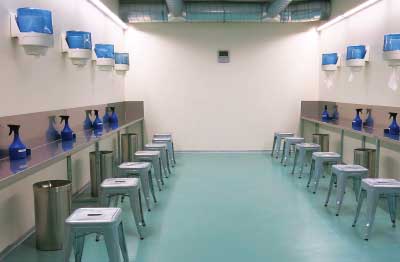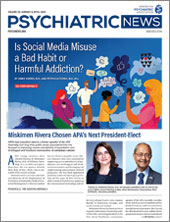Switzerland Halts War on Drugs, Cuts Deaths
Abstract
Switzerland lowers the threshold for medication-assisted treatment, even in prison, and cuts opioid overdoses and treatment costs.
Switzerland has found an unorthodox method—at least by U.S. standards—of solving its opioid crisis: decriminalizing substance use; offering 24-hour-a-day access to methadone programs; and, for treatment-resistant cases, offering pharmaceutical-grade heroin in clinics.

At the Hindelbank women’s prison in the Canton of Bern in Switzerland, the first goal is rehabilitation, and women move freely around the facility.
Michael Liebrenz, M.D., a forensic psychiatry professor at the University of Bern’s Institute of Forensic Medicine in Switzerland, told attendees at the APA Annual Meeting session “Emerging Ethical Considerations in a Globalized Psychiatry” that the country’s overdose deaths have dropped by one-third since instituting these programs.
The United States locks up more people per capita than any other nation: More than 860 adults are incarcerated for every 100,000, according to Bureau of Justice Statistics. This is more than 10 times Switzerland’s incarceration rate (83 per 100,000), and more than seven times that of Europe (117 per 100,000), according to Council of Europe data. “It’s not that U.S. citizens are more violent or engage in more criminal behavior than those in Europe. The difference is in our differing approach to illicit drugs,” Liebrenz said.
In fact, half of all federal prison inmates in the United States are drug offenders, according to the United States Sentencing Commission. Many of those convicted of a drug crime must serve a mandatory minimum sentence, and those are more than double the average nonmandatory sentences. Nearly half of those convicted of a drug offense carrying a mandatory minimum had little to no prior criminal history (46 percent).
In Switzerland, the “war on drugs” and abstinence-based treatment and prevention were not living up to the country’s expectations, Liebrenz said. It had some 30,000 citizens addicted to opioids by the 1980s, and communes of impoverished addicts had taken over several large public parks, with up to 3,000 people openly injecting heroin in just one of these “needle parks” daily. Most were homeless and jobless. In 1991, paramedics were called in 3,600 times to one needle park alone to resuscitate people who had overdosed on heroin. HIV/AIDS and hepatitis C were rampant among the heroin users, and the country was often referred to as a “drug swamp” in popular media, he added.

At one workshop, a specially trained social worker teaches inmates employment skills, as they learn step by step how to process raw textiles and produce dresses and accessories.
Starting in 1991, the country began a major paradigm shift based on the concept of harm reduction: it decriminalized drug consumption, and to stop overdose deaths and the spread of HIV/AIDS, it opened clean, supervised consumption rooms where users can inject themselves with substances they bring in and exchange used needles for clean ones. “The offers of help no longer reached just the drug users who wanted to quit, but also those who were still unwilling or not capable of doing it,” Liebrenz said.
Twenty-four hours a day, heroin users can now call a hotline staffed by psychiatrists and other mental health professionals and begin immediate methadone treatment. Patients in the program do not have to visit every day, which disrupts employment opportunities, Liebrenz said. Rather, they are given a two- or three-week supply of methadone to use at home and then head to their jobs.
Methadone patients who continue to use illegal heroin are offered heroin-assisted treatment (HAT) for which they receive pharmaceutical grade heroin during daily visits to a clinic staffed by medical professionals. HAT is even being piloted in one men’s jail.
The cost savings for its opioid abuse treatment programs have been great: the six-month cost to the Swiss government for treating a person in its outpatient methadone treatment was $1,750, compared to $20,000 for six months of incarceration, or $21,500 for not providing any treatment, Liebrenz said. The prevalence of opioid dependence has remained fairly constant, however. “Those who get addicted, stay addicted,” Liebrenz said. “But new cases of opioid use have fallen to almost zero.”

At a Swiss “reception center,” opioid users can inject themselves with substances they bring in―under medical supervision―and with sterile needles. The centers have lowered disease transmission and overdose deaths.
Other positive results include a huge drop in overdose deaths, crime, and the spread of HIV and hepatitis. Participants have improved social functioning and employment, he added.
However, Swiss women who inject drugs, especially migrant women, enter treatment later and with higher rates of HIV infection. Women might be delaying treatment due to lack of services for pregnant women or even fear of losing custody of a child—valid concerns, Liebrenz said. Methadone and buprenorphine for maintenance therapy have now been expanded to women in Swiss prisons.
Women incarcerated in Switzerland, many of whom are migrants, have a high rate of dual diagnosis of mental illness and opioid use disorder, he said. More than half suffered childhood neglect, and about one-quarter experienced sexual abuse. Many were incarcerated for drug-trafficking crimes, such as carrying drugs into the country for others. Although the prisons have bars at the entrances, they are bright and colorful with curtained windows and are surrounded by expansive green lawns.
“We have found some solutions to the opioid crisis. This is ethics at work. And we have found a way to take care of the migrant women who suffer from substance abuse and mental illness who have been used as mules to bring illicit substances into our country,” Liebrenz said. ■



